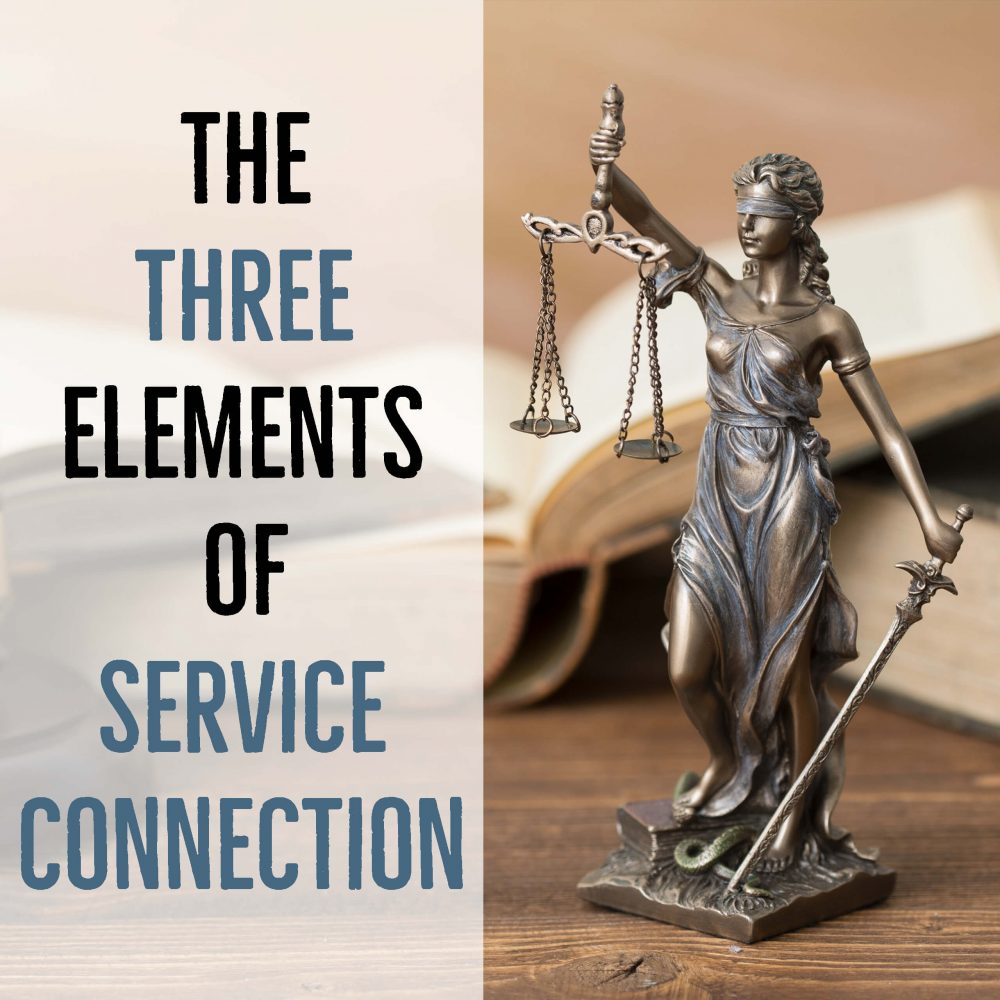The 3 Essential Elements of Service Connection

CCK Law: Our Vital Role in Veterans Law
In order for any VA disability claim for service connection to be successful, three main elements must be present. Service connection means that a veteran’s disability or death was incurred during or aggravated by his or her military service. In order to establish service connection on a direct basis, veterans must show evidence of:
- A current, diagnosed disability;
- An in-service event, injury, or illness; and
- A medical nexus between the current disability and the in-service event, injury, or illness.

Element 1: Current, Diagnosed Disability
For VA purposes, a disability is any disease or injury incurred in service that causes a decrease in earning capacity. There are some conditions that VA does not consider eligible for service connection, such as congenital or hereditary diseases and conditions that result from a veteran’s own willful misconduct.
The easiest way to show proof of a disability is through a current diagnosis reported in medical records. Veterans may be eligible for service connection even without a current diagnosis; for example, a veteran experiencing chronic pain which impedes his or her ability to work may be eligible for service connection for pain if medical evidence supports it. Another example in which a diagnosis may not be necessary are Gulf War veterans experiencing “Gulf War Syndrome”, as these clusters of symptoms are difficult to definitively attribute to a condition.
Diagnoses must be current in order to qualify for VA disability compensation. Disabilities incurred in service that have since healed and no longer impair earning capacity are not eligible for VA compensation. For example, a veteran who developed prostate cancer as a result of Agent Orange exposure is eligible for disability compensation while the cancer is active; however, if the cancer goes into remission and the veteran is left with no residual symptoms, he is no longer eligible for disability benefits for the cancer.
Element 2: In-Service Event, Injury, or Illness
The second element of service connection is an in-service event, injury, or illness that occurred while on active duty. Disabilities do not have to have been incurred in a combat situation; any illness, injury, or event that arose during active duty military service can be eligible for a disability rating.
It is important to note that disabilities that arose due to a veteran’s own willful misconduct do not qualify for VA benefits. According to VA, willful misconduct is “an act involving conscious wrongdoing or known prohibited action.” For example, if an active-duty servicemember was involved in a car accident in which s/he was driving under the influence of alcohol and became injured, residuals of that injury would not be eligible for compensation.
How do veterans show VA that the event, injury, or illness occurred?
The best forms of evidence to prove the second element of service connection are service treatment records and service records. Service treatment records will have documented any injury or illness for which you were treated while on active duty; these are the best form of evidence to prove a condition arose during service. Service records are also quite useful, as they may hold documentation of the event or injury that occurred, such as a bad fall or a specific training exercise.
Unfortunately, not all veterans have this type of evidence available to them. In this circumstance, lay statements from the veteran can be particularly effective when coupled with buddy statements from those who served with them and witnessed the event. These statements can help corroborate when and how the event occurred.
Must veterans prove the event, injury, or illness occurred during service in every situation?
There are some exceptions to the second element of service connection. One of these situations is presumptions. The most well-known example of a presumption are benefits for veterans with “boots on the ground” service in Vietnam. To prove service connection, these veterans only have to show a current diagnosis of an Agent Orange-related condition and that they were “boots on the ground” in Vietnam during the time period VA has defined.
Another situation for which veterans do not have to provide documentation that an event occurred are for Military Sexual Trauma claims. These events often go unreported for a number of reasons, which VA acknowledges. These claims can be supported by lay evidence, buddy statements, and a review of the veteran’s behavior through time—before and after the event.
Element 3: Medical Nexus
A medical nexus is the link between your current disability and the event, injury, or illness during service. The best way to establish a nexus is through medical evidence. A statement from your treating doctor affirming that they believe your condition was “at least as likely as not” caused by military service can prove to be a powerful piece of evidence.
As part of VA’s duty to assist veterans in obtaining evidence to support their claims, the department will schedule a medical examination to assess the severity and origin of the veteran’s condition. The findings of this Compensation and Pension (C&P) Examination may help to establish a medical nexus. If the results of this examination are not favorable, veterans may bring the report to another medical professional for a second opinion.
What makes a doctor’s medical opinion stronger?
Not all medical evidence is weighed the same by VA when time comes for adjudication. There are some ways to ensure medical opinions hold as much probative value as possible, such as:
- The opinion is written by a licensed professional practicing in an appropriate clinical field or specialty. For example, a podiatrist opining on a veteran’s thyroid condition may not be a sufficient medical opinion to establish a nexus.
- The opinion should be tailored to the veteran and based on his or her service and medical records, as well as personal medical history before and after service.
- The opinion notes that the veteran’s condition was “at least as likely as not” incurred in or caused by military service.
- The opinion provides supporting rationale for the claim. In other words, the medical professional “shows their work” by elaborating on how they reached their conclusion.
About the Author
Share this Post
